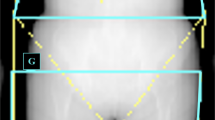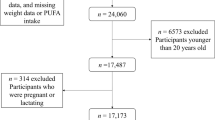Abstract
Background/objectives:
Studies in adults indicate that dietary polyunsaturated fatty acid (PUFA) composition may play a role in development of adiposity. Because adipocyte quantity is established between late childhood and early adolescence, understanding the impact of PUFAs on weight gain during the school-age years is crucial to developing effective interventions.
Subjects/methods:
We quantified N-3 and N-6 PUFAs in serum samples of 668 Colombian schoolchildren aged 5–12 years at the time of recruitment into a cohort study, using gas–liquid chromatography. Serum concentrations of N-3 (alpha-linolenic acid (ALA), eicosapentaenoic acid, docosahexaenoic acid) and N-6 PUFAs (linoleic acid, gamma-linolenic acid, dihomo-gamma-linolenic acid, arachidonic acid) were determined as percentage total fatty acids. Children’s anthropometry was measured annually for a median of 30 months. We used mixed-effects models with restricted cubic splines to construct population body mass index-for-age z-score (BAZ) growth curves for age- and sex-specific quartiles of each PUFA.
Results:
N-3 ALA was inversely related to BAZ gain after adjustment for sex, baseline age and weight status, as well as household socioeconomic level. Estimated BAZ change between 6 and 14 years among children in the highest quartile of ALA compared with those in the lowest quartile was 0.45 (95% confidence interval: 0.07, 0.83) lower (P-trend=0.006).
Conclusions:
N-3 ALA may be protective against weight gain in school-age children. Whether improvement in PUFA status reduces adiposity in pediatric populations deserves evaluation in randomized trials.
This is a preview of subscription content, access via your institution
Access options
Subscribe to this journal
Receive 12 print issues and online access
$259.00 per year
only $21.58 per issue
Buy this article
- Purchase on Springer Link
- Instant access to full article PDF
Prices may be subject to local taxes which are calculated during checkout
Similar content being viewed by others
References
Rivera JA, de Cossio TG, Pedraza LS, Aburto TC, Sanchez TG, Martorell R . Childhood and adolescent overweight and obesity in Latin America: a systematic review. Lancet Diabetes Endocrinol 2014; 2: 321–332.
de Onis M, Blossner M, Borghi E . Global prevalence and trends of overweight and obesity among preschool children. Am J Clin Nutr 2010; 92: 1257–1264.
Massiera F, Saint-Marc P, Seydoux J, Murata T, Kobayashi T, Narumiya S et al. Arachidonic acid and prostacyclin signaling promote adipose tissue development: a human health concern? J Lipid Res 2003; 44: 271–279.
Cintra DE, Ropelle ER, Moraes JC, Pauli JR, Morari J, Souza CT et al. Unsaturated fatty acids revert diet-induced hypothalamic inflammation in obesity. PLoS One 2012; 7: e30571.
Ruzickova J, Rossmeisl M, Prazak T, Flachs P, Sponarova J, Vecka M et al. Omega-3 PUFA of marine origin limit diet-induced obesity in mice by reducing cellularity of adipose tissue. Lipids 2004; 39: 1177–1185.
Buckley JD, Howe PR . Long-chain omega-3 polyunsaturated fatty acids may be beneficial for reducing obesity-a review. Nutrients 2010; 2: 1212–1230.
Martinez-Victoria E, Yago MD . Omega 3 polyunsaturated fatty acids and body weight. Br J Nutr 2012; 107 (Suppl 2): S107–S116.
Donahue SM, Rifas-Shiman SL, Gold DR, Jouni ZE, Gillman MW, Oken E . Prenatal fatty acid status and child adiposity at age 3 y: results from a US pregnancy cohort. Am J Clin Nutr 2011; 93: 780–788.
Pedersen L, Lauritzen L, Brasholt M, Buhl T, Bisgaard H . Polyunsaturated fatty acid content of mother's milk is associated with childhood body composition. Pediatr Res 2012; 72: 631–636.
Muhlhausler BS, Gibson RA, Makrides M . Effect of long-chain polyunsaturated fatty acid supplementation during pregnancy or lactation on infant and child body composition: a systematic review. Am J Clin Nutr 2010; 92: 857–863.
Burrows T, Collins CE, Garg ML . Omega-3 index, obesity and insulin resistance in children. Int J Pediatr Obes 2011; 6: e532–e539.
Klein-Platat C, Drai J, Oujaa M, Schlienger JL, Simon C . Plasma fatty acid composition is associated with the metabolic syndrome and low-grade inflammation in overweight adolescents. Am J Clin Nutr 2005; 82: 1178–1184.
Karlsson M, Marild S, Brandberg J, Lonn L, Friberg P, Strandvik B . Serum phospholipid fatty acids, adipose tissue, and metabolic markers in obese adolescents. Obesity 2006; 14: 1931–1939.
Spalding KL, Arner E, Westermark PO, Bernard S, Buchholz BA, Bergmann O et al. Dynamics of fat cell turnover in humans. Nature 2008; 453: 783–787.
Arsenault JE, Mora-Plazas M, Forero Y, Lopez-Arana S, Marin C, Baylin A et al. Provision of a school snack is associated with vitamin B-12 status, linear growth, and morbidity in children from Bogota, Colombia. J Nutr 2009; 139: 1744–1750.
de Onis M, Onyango AW, Borghi E, Siyam A, Nishida C, Siekmann J . Development of a WHO growth reference for school-aged children and adolescents. Bull World Health Organ 2007; 85: 660–667.
Durrleman S, Simon R . Flexible regression models with cubic splines. Stat Med 1989; 8: 551–561.
Perng W, Mora-Plazas M, Marin C, Villamor E . Iron status and linear growth: a prospective study in school-age children. Eur J Clin Nutr 2013; 67: 646–651.
Gil-Campos M, del Carmen Ramirez-Tortosa M, Larque E, Linde J, Aguilera CM, Canete R et al. Metabolic syndrome affects fatty acid composition of plasma lipids in obese prepubertal children. Lipids 2008; 43: 723–732.
Schwab U, Seppanen-Laakso T, Yetukuri L, Agren J, Kolehmainen M, Laaksonen DE et al. Triacylglycerol fatty acid composition in diet-induced weight loss in subjects with abnormal glucose metabolism—the GENOBIN study. PLoS One 2008; 3: e2630.
Boeke CE, Oken E, Kleinman KP, Rifas-Shiman SL, Taveras EM, Gillman MW . Correlations among adiposity measures in school-aged children. BMC Pediatr 2013; 13: 99.
Ide T . Effect of dietary alpha-linolenic acid on the activity and gene expression of hepatic fatty acid oxidation enzymes. Biofactors 2000; 13: 9–14.
Murase T, Nagasawa A, Suzuki J, Wakisaka T, Hase T, Tokimitsu I . Dietary alpha-linolenic acid-rich diacylglycerols reduce body weight gain accompanying the stimulation of intestinal beta-oxidation and related gene expressions in C57BL/KsJ-db/db mice. J Nutr 2002; 132: 3018–3022.
DeLany JP, Windhauser MM, Champagne CM, Bray GA . Differential oxidation of individual dietary fatty acids in humans. Am J Clin Nutr 2000; 72: 905–911.
Burdge GC, Finnegan YE, Minihane AM, Williams CM, Wootton SA . Effect of altered dietary n-3 fatty acid intake upon plasma lipid fatty acid composition, conversion of [13C]alpha-linolenic acid to longer-chain fatty acids and partitioning towards beta-oxidation in older men. Br J Nutr 2003; 90: 311–321.
Vermunt SH, Mensink RP, Simonis MM, Hornstra G . Effects of dietary alpha-linolenic acid on the conversion and oxidation of 13C-alpha-linolenic acid. Lipids 2000; 35: 137–142.
Phinney SD, Tang AB, Thurmond DC, Nakamura MT, Stern JS . Abnormal polyunsaturated lipid metabolism in the obese Zucker rat, with partial metabolic correction by gamma-linolenic acid administration. Metabolism 1993; 42: 1127–1140.
Schirmer MA, Phinney SD . Gamma-linolenate reduces weight regain in formerly obese humans. J Nutr 2007; 137: 1430–1435.
Baylin A, Mora-Plazas M, Cobos-de Rangel O, Lopez-Arana S, Campos H, Villamor E . Predictors of usage and fatty acid composition of cooking fats in Bogota, Colombia. Public Health Nutr 2009; 12: 531–537.
Hibbeln JR, Nieminen LR, Blasbalg TL, Riggs JA, Lands WE . Healthy intakes of n-3 and n-6 fatty acids: estimations considering worldwide diversity. Am J Clin Nutr 2006; 83: 1483s–1493s.
Baylin A, Kim MK, Donovan-Palmer A, Siles X, Dougherty L, Tocco P et al. Fasting whole blood as a biomarker of essential fatty acid intake in epidemiologic studies: comparison with adipose tissue and plasma. Am J Epidemiol 2005; 162: 373–381.
Acknowledgements
This study was supported by the University of Michigan Nutrition Obesity Research Center (NORC) pilot grant (P30 DK089503) and the ASISA Research Fund at the University of Michigan.
Author information
Authors and Affiliations
Corresponding author
Ethics declarations
Competing interests
The authors declare no conflict of interest.
Rights and permissions
About this article
Cite this article
Perng, W., Villamor, E., Mora-Plazas, M. et al. Alpha-linolenic acid (ALA) is inversely related to development of adiposity in school-age children. Eur J Clin Nutr 69, 167–172 (2015). https://doi.org/10.1038/ejcn.2014.210
Received:
Revised:
Accepted:
Published:
Issue Date:
DOI: https://doi.org/10.1038/ejcn.2014.210
This article is cited by
-
Identification and stacking of crucial traits required for the domestication of pennycress
Nature Food (2020)
-
Polyunsaturated fatty acids in middle childhood and externalizing and internalizing behavior problems in adolescence
European Journal of Clinical Nutrition (2020)
-
Integrated analysis of transcriptomic and proteomic data from tree peony (P. ostii) seeds reveals key developmental stages and candidate genes related to oil biosynthesis and fatty acid metabolism
Horticulture Research (2019)



